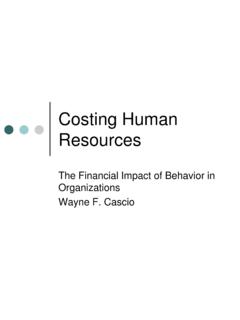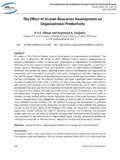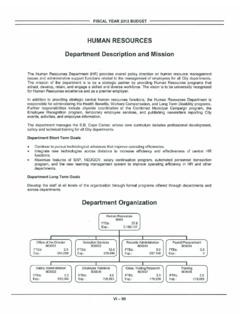Transcription of Planning human resources development to achieve priority ...
1 Planning human resources development to achieve priority health programme goals human resources for health development world health organization This paper is a revised version of an earlier guideline developed by G. Weiler, N. Dreesch, and Poz, WHO for the 3by5 Initiative. It was prepared by N. Dreesch, WHO. GFATM Round 8, 2008 Page 1 Planning human resources development to achieve priority health programme goals (1) Constitute HR Working Group Partnerships (3) HR component of Scale-up approach (2) Assess HR availability & education (4) Develop recruitment & retention strategy / plan(5) Define competenciesper cadre(7) Develop Training Material and Capacity(6) Define education roll-out strategy / plan(10) Monitoring and Improvement (9) Quality control and certification (8) FundingWorkforce availability Workforce education Implementation human Capacity Building Plan OPERATIONAL STEPS FOR DEVELOPING THE human resources development COMPONENT OF SCALE UP PLANS AND FUNDING 3 1.
2 Have partnerships for capacity building been established?.. 6 2. Is there a good understanding of the human resource situation?.. 6 3. Have the human resource needs of the scale-up model been identified?.. 8 4. human resource recruitment and 10 5. Competencies and curricula for groups involved in priority disease 11 6. Appropriate training material and trained 11 7. Plan / strategy for in- and pre-service 13 8. Funding for human resource development and 14 9. Authorization to practice and 14 10. Continuous monitoring of human resources building 15 SUMMARY OF TECHNICAL AND EXPERT resources ..ERROR! BOOKMARK NOT DEFINED. PERSONAL SUPPORT BY WHO/HQ ! BOOKMARK NOT DEFINED. TOOLS AND 16 GFATM Round 8, 2008 Page 2 GFATM Round 8, 2008 Page 3 Operational steps for developing the human resources development component of scale up plans and funding proposals It is estimated that globally 4 million health workers are lacking (WHR, 2006).
3 The GFATM and other funding agencies will address the health workforce shortages by accepting proposals which will help reduce it . People need to be trained for their contribution to achieving targets for the three diseases within strengthening of a Primary health Care context. The challenge in this situation of dedicated disease funding lies in the identification of human resources development and training interventions which have both medium and long term impact on the disease while at the same time strengthening the underlying PHC health systems infrastructure. human resource aspects should hence be considered as an integral part of the overall development of the national service delivery strategy and scale-up plan. One of the most important things to bear in mind when writing up a proposal for funding agencies with a clearly circumscribed mandate such as the GFATM is to clearly: 1.
4 Identify what exactly constitutes the problem needing to be addressed in the specific disease area 2. Indicate how strengthening of the human resources problems will benefit the disease programme 3. Respond to the need to quantify the interventions needing to be undertaken 4. Cost the interventions over the coming years 5. Attach indicators for measuring implementation at regular intervals. The funding agency guidelines often make this very clear, but proposals do not always conform with the request and risk getting rejected because of inattention to these issues. It should be borne in mind by those supporting the preparation of proposals that those reviewing proposals are not necessarily human resources specialists. Clarity of problem statement and simple links throughout the text how, for example, the proposal to start training medical assistants or clinical officers will address the size of an epidemic and reduce its impact.
5 It should therefore be pointed out that this is a proven intervention, with less than half the training time for a medical doctor, and, in the absence of other alternatives a viable option to address the epidemic. The proposal should clearly indicate the phases implementation and the link between requested human resources strengthening measures, phased in arrival of supplies and equipment when these resources become available (no point raining someone and then having to wait for another project cycle to deliver the drugs to be used ..), or measures to upgrade training capacity or enrolment extensions of buildings, phased project support to the arrival of external additional teaching staff, etc. The proposal development process The working group for the development of the proposal should include all national and international stakeholders relevant for developing a human resources scale up proposal.
6 This includes ministry of finance, education, the public services commission and health and the usually required representatives of the local NGO community. Here it is also important that the local NGO representatives play an active role. In the case of HIV'AIDS, for example, one of the successful elements of the Malawi proposal was the inclusion of training of PLHA in the community health services as providers of care. The idea being that in addition to not just having some of them working as volunteers one would also use the power of wearing a white coat, delivering services as a respected member of a health team, and help to reduce stigma and make people come forward for treatment, prevention and care for HIV. Depending on when the consultant support is requested, these meetings will already have established concept notes or papers which will form the background for feeding into the proposal.
7 If support is GFATM Round 8, 2008 Page 4 requested earlier, the consultancy services should also help drive the inclusion of national stakeholders in the process. What is important, however, is to start the process of creating consensus around the development issues as early as possible and start building up the proposal document, in the format required and responding to the information needs. This may not always be easy to follow, but every effort should be made to respond in the requested way. The reason is simple; the GFATM Technical Review Panel will have to judge the proposals on the basis of a level playing field. Therefore the merits of each proposal must be presented in a more or less uniform way facilitating fair technical judgement. Another challenge in this respect lies in the fact that multiple stakeholders will be involved in support HR development . It is important to provide a detailed picture of who is already supporting what, where the gaps lie, and how the proposal will fit into on going efforts.
8 This will help the TRP see whether a well coordinated effort is underway between public and private contributors to HR development , and how the proposed measures will bring additional support to fill the gap. The document Section 1 identifies essential stakeholder and partnership issues. Sections 2 to 4 address basic steps that lead to identifying and making available the human resources that are needed based on the national scale-up model. Sections 5 to 7 address efforts to equip health workers with the necessary knowledge and skills. These include a definition of the competencies for various cadres, the development of appropriate training material, and the design of pre- and in-service training plans. The final sections 8 to 10 of the document discuss issues related to the implementation of human resource and training plans, including the availability of adequate funding, certification and quality control, and monitoring and improving human resource development .
9 The human resources development and capacity building plan From a country perspective, major bottlenecks in successfully responding to human resource challenges in the health sector include 1) the absence of a concerted human resource development and training approach to recruiting, training and retaining the workforce; 2) multiple and sometimes conflicting training materials in use; 3) lack of training provider capacity; 4) insufficient quality control and certification systems in the training sector; and 5) insufficient financial resources for training, and many other relevant factors identified in the 2006 world health Report. The generic human resources Capacity-Building Plan below describes WHO and partner support to countries in overcoming barriers described above to ensure both the emergency expansion of the health workforce and long-term sustainability of human resources in the health sector (Table 1).
10 Geared towards addressing the MDG priority diseases including HIV as a specific entity, it is firmly anchored in the concept of the three 'Ones' promoted by the UN for this area: One agreed HIV/AIDS Action Framework that drives alignment of all partners. One national AIDS authority, with a broad-based multisectoral mandate. One agreed country-level monitoring and evaluation system. It should, however, be borne in mind that national coordination towards a unified approach to human resources development across the health sector does demand an agreed framework to which all partners agree. These are usually coordinated by SWAP mechanisms, or regular national country coordinating meetings between all partners. GFATM Round 8, 2008 Page 5 Table 1 Elements of WHO human Capacity-Building Plan Countries Regional Global human resource Planning Support development of ONE country human resource and training plan Technical resource Networks and regional guidance for human resource Assessment and Planning Shared understanding of tools and guidelines for HR Planning amongst key technical, donor and academic institutions; development of core guidance.

















